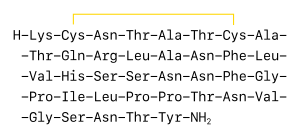Pramlintide
Pramlintide (trade name Symlin) is an injectable amylin analogue drug for diabetes (both type 1 and 2), developed by Amylin Pharmaceuticals (now a wholly owned subsidiary of AstraZeneca).[1] Pramlintide is sold as an acetate salt.
 Golden line indicates disulfide bond | |
| Clinical data | |
|---|---|
| Trade names | Symlin |
| AHFS/Drugs.com | Monograph |
| MedlinePlus | a605031 |
| Pregnancy category |
|
| Routes of administration | Subcutaneous |
| ATC code | |
| Legal status | |
| Legal status |
|
| Pharmacokinetic data | |
| Bioavailability | 30 to 40% |
| Protein binding | ~60% |
| Metabolism | Renal |
| Elimination half-life | ~48 minutes |
| Identifiers | |
| CAS Number | |
| PubChem CID | |
| IUPHAR/BPS | |
| DrugBank | |
| ChemSpider | |
| UNII | |
| KEGG | |
| ChEMBL | |
| Chemical and physical data | |
| Formula | C171H269N51O53S2 |
| Molar mass | 3951.41 g/mol g·mol−1 |
| 3D model (JSmol) | |
SMILES
| |
InChI
| |
| | |
Pharmacology
Pramlintide is an analogue of amylin, a small peptide hormone that is released into the bloodstream by the β cells of the pancreas along with insulin after a meal.[2] Like insulin, amylin is completely absent in individuals with Type I diabetes.[3]
In synergy with endogenous amylin, pramlintide aids in the regulation of blood glucose by slowing gastric emptying, promoting satiety via hypothalamic receptors (different receptors than for GLP-1), and inhibiting inappropriate secretion of glucagon, a catabolic hormone that opposes the effects of insulin and amylin. Pramlintide also has effects in raising the acute first-phase insulin response threshold following a meal.
Both a reduction in glycated hemoglobin and weight loss have been shown in insulin-treated patients with type 2 diabetes taking pramlintide as an adjunctive therapy.[4]
Approval
Pramlintide has been approved by the FDA, for use by type 1 and type 2 diabetic patients who use insulin.[5] Pramlintide allows patients to use less insulin, lowers average blood sugar levels, and substantially reduces what otherwise would be a large unhealthy rise in blood sugar that occurs in diabetics right after eating.
Apart from insulin analogs, pramlintide is the only drug approved by the FDA to lower blood sugar in type 1 diabetics since insulin in the early 1920s.[6]
Design and structure
Since native human amylin is highly amyloidogenic and potentially toxic, the strategy for designing pramlintide was to substitute residues from rat amylin, which is less amyloidogenic although not completely [7][8] (but would presumably retain clinical activity). Proline residues are known to be structure-breaking residues, so these were directly grafted into the human sequence. Despite its enhanced stability compared to human amylin, pramlintide is still able to organize into amyloid material.[9]
Amino acid sequences:
| Pramlintide | KCNTATCATQRLANFLVHSSNNFGPILPPTNVGSNTY-(NH2) |
| Amylin | KCNTATCATQRLANFLVHSSNNFGAILSSTNVGSNTY-(NH2) |
| Rat amylin | KCNTATCATQRLANFLVRSSNNLGPVLPPTNVGSNTY-(NH2) |
Pramlintide as protein is (positively charged).
References
- Taylor, Phil (19 December 2013). "AstraZeneca buys BMS out of diabetes alliance". Retrieved 16 June 2014.
- Jones MC (2007). "Therapies for diabetes: pramlintide and exenatide" (PDF). American Family Physician. 75 (12): 1831–5. PMID 17619527.
- Edelman, Steve; Maier, Holly; Wilhelm, Ken (2008). "Pramlintide in the Treatment of Diabetes Mellitus". BioDrugs. 22 (6): 375–386. doi:10.2165/0063030-200822060-00004. ISSN 1173-8804. PMID 18998755.
- Hollander, Priscilla; Maggs, David G.; Ruggles, James A.; Fineman, Mark; Shen, Larry; Kolterman, Orville G.; Weyer, Christian (2004). "Effect of Pramlintide on Weight in Overweight and Obese Insulin-Treated Type 2 Diabetes Patients" (PDF). Obesity. 12 (4): 661–668. doi:10.1038/oby.2004.76. ISSN 1930-7381. PMID 15090634.
- Ryan GJ, Jobe LJ, Martin R (2005). "Pramlintide in the treatment of type 1 and type 2 diabetes mellitus". Clinical Therapeutics. 27 (10): 1500–12. doi:10.1016/j.clinthera.2005.10.009. PMID 16330288.
- "Dual-Hormone, Artificial Pancreas with Insulin and Pramlintide Significantly Improves Glucose Levels, Compared to Insulin-Only Artificial Pancreas". American Diabetes Association. Retrieved 2018-08-28.
- Palmieri, Leonardo C; Melo-Ferreira, Bruno; Braga, Carolina A; Fontes, Giselle N; Mattos, Luana J; Lima, Luis Mauricio (2013). "Stepwise oligomerization of murine amylin and assembly of amyloid fibrils". Biophys Chem. 181: 135–144. doi:10.1016/j.bpc.2013.07.013. PMID 23974296.CS1 maint: uses authors parameter (link)
- Erthal, Luiza C; Marques, Adriana F; Almeida, Fábio C; Melo, Gustavo L; Carvalho, Camila M; Palmieri, Leonardo C; Cabral, Kátia M; Fontes, Giselle N; Lima, Luis Mauricio (2016). "Regulation of the assembly and amyloid aggregation of murine amylin by zinc". Biophys. Chem. 218: 58–70. doi:10.1016/j.bpc.2016.09.008. PMID 27693831.CS1 maint: uses authors parameter (link)
- da Silva, Dayana C; Fontes, Giselle N; Erthal, Luiza C; Lima, Luis Mauricio. (2016). "Amyloidogenesis of the amylin analogue pramlintide". Biophys. Chem. 219: 1–8. doi:10.1016/j.bpc.2016.09.007. PMID 27665170.CS1 maint: uses authors parameter (link)
External links
- www.symlin.com - product website
- www.amylin.com - Symlin page on the Amylin Pharmaceuticals website